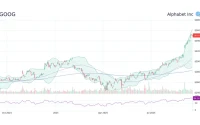The headline numbers painted a picture of broad-based relief. With lawmakers in Washington finally moving to avert a government shutdown, the Nasdaq Composite surged an impressive 2%, while the S&P 500 climbed 1.2%. On the surface, it looked like a classic "risk-on" day, a collective sigh of relief rippling through the markets.
But if you looked just one layer deeper, past the celebratory pop in the major indices, a very different and far more concerning story emerged. The Dow Jones Industrial Average, a broader (though admittedly flawed) measure of the market, was up a tepid 170 points, or about 0.4%. That’s a significant discrepancy. And then came the tell-tale data point, the one that should give any serious analyst pause: market breadth was negative.
Let that sink in. The major tech-heavy index was soaring, yet more stocks were declining than advancing. This isn't a rally; it's a narrowing. It’s the market equivalent of a magnificent cathedral being held up by just seven pillars while the foundation all around them quietly crumbles.
The Magnificent Seven's Heavy Lift
The entire story of the day—and arguably, the entire year—can be told by looking at a tiny handful of companies. The so-called "Magnificent Seven" were all up significantly, doing the heavy lifting for the entire market. Nvidia led the charge, jumping 3.9%. Alphabet and Tesla were both up over 3%. Amazon, Meta, Microsoft, and Apple all posted gains of 1.7% or more. The performance was, in a word, concentrated.
This isn't just an observation; it's a structural vulnerability. Chris Larkin from E*TRADE noted that "Tech continues to be the story for the stock market," and that any bounce may hinge on "whether the market's AI leaders regain momentum." He’s not wrong, but that statement itself highlights the precariousness of the situation. When the health of the entire market ecosystem depends on the sentiment surrounding a single theme like AI, embodied by just a few mega-cap stocks, the system becomes inherently fragile.
It's a strange sensation, watching the Nasdaq ticker flash a brilliant green while a sea of red washes over the majority of individual stocks on your screen. You see the celebration on financial news, with headlines like Stock Market Today: Dow, S&P 500, Nasdaq Open Up; Nvidia, Tesla, More Movers; Shutdown Hope, but the underlying data tells a story of decay. Mizuho’s Jordan Klein suggested that investors were just waiting for an excuse to buy last week's dip and that he expects "MORE OF THE SAME in terms of what gets bought and chased most aggressively." I've read hundreds of analyst notes, and this is the kind of observation that I find genuinely troubling. "More of the same" is precisely the problem. It signals a feedback loop, a momentum chase that has become detached from broad economic fundamentals and is now feeding on itself.

How long can seven stocks defy gravity for the other 493 companies in the S&P 500? What happens when the narrative driving one of those seven pillars begins to crack?
Breadth, Belief, and Structural Risk
Let’s be precise about the divergence. The Nasdaq’s 2% gain was driven almost entirely by these few names. The Dow’s gain was closer to 0.5%—to be more exact, 0.4%. This isn't just a rounding error; it’s a chasm. It tells you that capital isn’t flowing into the market broadly; it's stampeding into a very small, very crowded room. The government shutdown news (a resolution that was widely expected, by the way) merely served as the catalyst, the "excuse to buy the dip" that Klein mentioned.
This is the kind of market action that feels good in the short term but often ends poorly. A healthy, sustainable bull market is like a rising tide that lifts all boats. It’s characterized by strong, positive market breadth, where a vast majority of stocks are participating in the upswing. What we're witnessing now is the opposite. It’s a geyser, a powerful but narrow eruption of capital into a handful of names while the surrounding landscape remains arid.
I'm less interested in the "why" of today's pop and more interested in the "how." How is the market achieving these gains? The answer is through an extreme and growing concentration of risk. Investors are making a collective bet that the earnings power and growth potential of these seven companies are so immense that they can single-handedly pull the entire weight of the market averages upward indefinitely. It’s a bold bet. And a very, very dangerous one.
Does anyone truly believe this is sustainable? Or are we simply in a phase where everyone is dancing because the music is still playing, hoping they’ll be close to a chair when it stops?
The Data Reveals a Fragile Consensus
Let's dispense with the celebratory tone. Today was not a sign of a healthy, recovering market. It was a demonstration of its profound sickness: an extreme dependency on a handful of mega-cap tech stocks. The negative market breadth isn't a footnote; it's the headline. It tells you the real story is one of weakness, masked by the spectacular performance of a few outliers. This isn't a market finding its footing; it's a market losing its balance, propped up by a few names that are now so large they distort the entire picture. The consensus is that these seven stocks can't lose. The data suggests that consensus is resting on a perilously top-heavy foundation.










